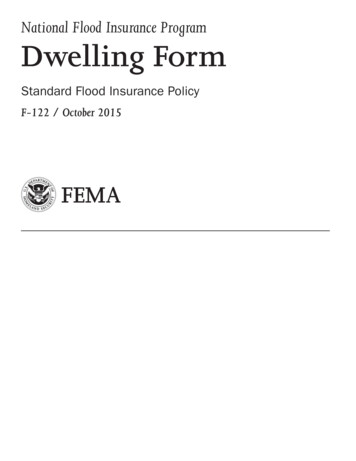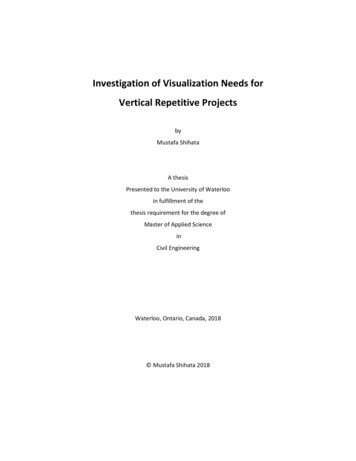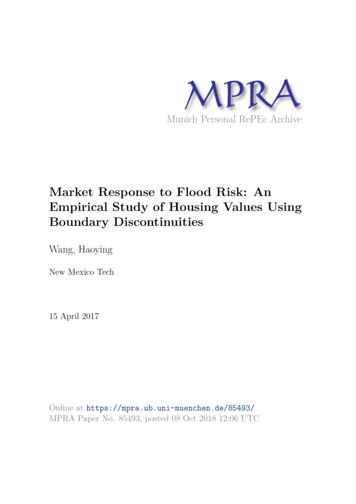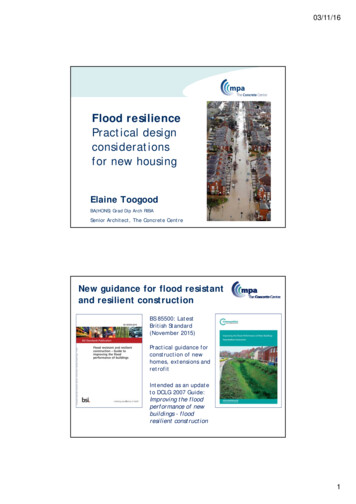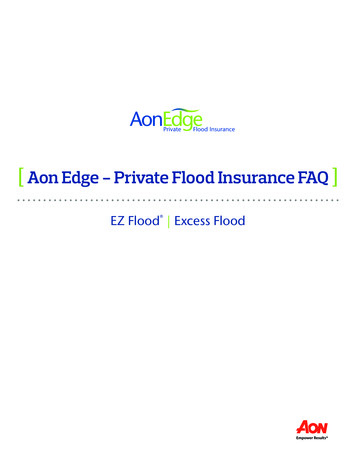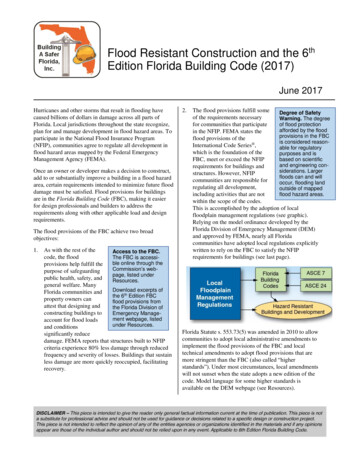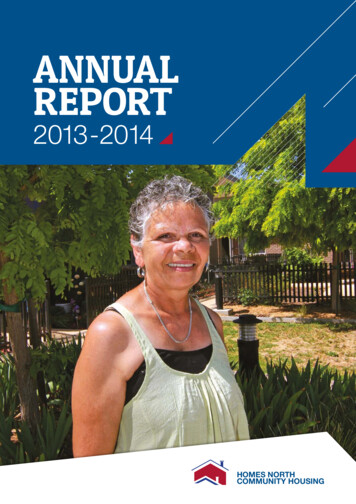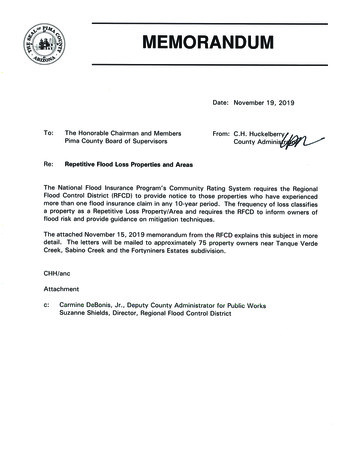
Transcription
DATENAMEADDRESSTucson AZ ZIPRe:Annual Notification to Repetitive Loss PropertyDear NAME:This is Pima County’s annual mailing on information regarding flood safety, preparedness, and propertyprotection. This letter is a simple reminder that your property is within an area subject to flood hazardand potential flood loss. The Federal Emergency Management Agency (FEMA) lists the above address asa Repetitive Loss Property in Pima County, meaning it has been subject to more than one loss due toflooding during a 10-year period.FEMA administers the National Flood Insurance Program (NFIP) that was designed to reduce flood lossesthrough local floodplain management and to provide federally backed flood insurance. Under theCommunity Rating System (CRS), there is an incentive for communities to do more than meet theminimum NFIP requirements by helping citizens prevent or reduce flood losses. The result of theCounty’s effort is that Pima County residents receive up to a 25% insurance discount.Attached is a parcel map showing that your property is in a FEMA Special Flood Hazard Area. Alsoattached is information on Increased Cost of Compliance (ICC) coverage, which supplements a floodinsurance claim payment by providing up to 30,000 to elevate, flood proof, rehabilitate to meet currentcode, demolish, or relocate a building that has been repetitively damaged. This information may be ofspecial interest after the latest flood.You may stop by our office to review the latest FEMA floodplain information and learn about safeconstruction methods that may reduce flood insurance premiums, retrofitting measures for residentialstructures and potential future flood control measures by Pima County. If you have any questions,please contact me at 724-4600.Sincerely,Greg Saxe, CRS CoordinatorCc: File Attachments
DateNameAddressTucson, AZ ZIPRe:Annual Notification to Repetitive Loss AreasDear Name:You have received this letter because your property is in a Repetitive Loss Area that has been identifiedby the Regional Flood Control District (District). A Repetitive Loss Area is a portion of the communitythat contains Repetitive Loss Properties (properties that have two or more claims within a ten yearperiod that have been paid by the National Flood Insurance Program) and nearby properties that havesimilar flooding conditions. Our community is concerned about repetitive flooding and has an activeprogram to help you protect yourself and your property from future flooding, but here are some thingsyou can do:1) Know your flood hazard:a. Check with the District on the extent of past flooding in your area. District staff can tellyou about the causes of repetitive flooding, and what would be appropriate measuresto protect your improvements from flooding.b. Request a visit by District hydrologists to discuss flood protection alternatives on yourproperty.2) Prepare for flooding by doing the following:a. Know how to shut off electricity and gas to your house when a flood occursb. Make a list of emergency numbers and identify safe places to goc. Make a household inventory list of important itemsd. Put insurance policies, valuable papers, medicine, etc., in a safe placee. Collect and put cleaning supplies, camera, waterproof boots, etc., in a handy placef. Develop a disaster response plan. A helpful guide to creating a response plan isattached.g. Get a copy of Repairing Your Flooded Home. The District has copies, or it can be foundon www.redcross.org3) Consider some permanent flood protection measures:a. Mark your fuse or breaker box to show the circuits for floodable areas. Turning off thepower to a basement or lower level area can reduce property and structural damage, aswell as help protect lives.b. Check your structure for water entry points, such as windows or vents. These can beprotected with low walls or temporary shieldsc. Install a flood drain plug, standpipe, or overhead sewer, or sewer backup valve toprevent sewer backup flooding
d. Note that some flood protection measures may require a floodplain and building permitand not all preventative measures may be applicable to your structuree. Consider elevating your home to or above flood levelsf. More information can be found on FEMA’s website, www.ready.gov/floods4) Talk to the District for information on flood insurance and financial resources:a. Obtain a flood insurance policy. Homeowner’s insurance policies do not cover damagefrom floods. However, you may purchase a separate policy for contents and structurecoverage. Since the District participates in the National Flood Insurance CommunityRating System Program, Pima County residents and property owners are eligible toreceive up to 25% of their premiums for flood insurance.b. Attached is information on Increased Cost of Compliance coverage, which supplementsa flood claim payment by providing a property owner with up to 30,000 in order tohelp elevate, flood proof, rehabilitate to meet current code, demolish, or relocate abuilding that has been repetitively damaged.c. Do not wait for the next flood to happen to buy flood insurance. Most policies take 30days to become effective.d. Contact your insurance agent for more information on rates and coverage.A map showing those properties that may also be impacted by a flood similar to that which caused therepetitive losses in your area is attached. You may download and print a detailed flood hazard map foryour parcel at:https://gis.pima.gov/apps/floodhazard/If you would like to learn how to reduce your flood risk, please stop by our office to review the latestFEMA floodplain information and learn about safe construction methods which reduce flood insurancepremiums, retrofitting measures for existing residential structures, and future flood control measures byPima County with one of our hydrologists. If you have any questions, please contact me at 724-4600.Sincerely,Greg Saxe, CRS CoordinatorGS/jcFile Attachments:Increased Cost of Compliance InformationRepetitive Loss Area MapEmergency Response Plan Guide
Mitigation Reduces FutureFlood DamageIs your building insured through the NationalFlood Insurance Program (NFIP) with aStandard Flood Insurance Policy (SFIP)? Ifso, you may be eligible for up to 30,000 inIncreased Cost of Compliance (ICC) coverage.ICC will help cover the costs of meeting thecommunity’s rebuilding requirements that willprotect your home from future flood damages.ICC coverage can help to pay the cost ofone or any combination of these fourmitigation activities.Elevate above the flood levelrequired by your communityRelocate to a new site,preferably out of the floodplainDemolish the buildingDry floodproof the building(primarily non-residential)ICC Helps Reduce Future Flood DamageFlooding badly damaged John Smith’s 200,000home. After John reported his flood loss to hisinsurance carrier, an assigned adjuster inspectedthe property and said he may be eligible toreceive ICC and should talk to his communitybuilding department.John contacted the community building departmentand after an inspection of the home, it was declaredsubstantially damaged. John and the buildingdepartment jointly decided elevating his home wasthe best way to meet the local floodplain rebuildingrequirements and reduce future flood damage.John provided the substantial damage letter hereceived from his community building departmentto the insurance carrier. After the insurance carrierverified that the flood damages equaled at least50 percent of the pre-flood market value, Johnqualified to receive ICC. After submitting a signedcontract for the work, a building permit from thebuilding department, and a signed ICC Proof of Lossform, John was ready to elevate his home*.*Check with your insurance carrier to determine if you are ableto receive a partial payment to help with the initial mitigationactivity costs.Your insurance carrier and community buildingdepartment can help you to determine your ICCeligibility and the documentation you will need.For more information about the NFIP,flood insurance, and ICC, contact yourinsurance carrier or visit www.FloodSmart.gov.National Flood Insurance ProgramIncreased Costof ComplianceCoverageReduces FutureFlood DamagesF-663
What is Increased Cost ofCompliance (ICC)?ICC coverage is included under the National FloodInsurance Program (NFIP) Standard Flood InsurancePolicy (SFIP). ICC helps policyholders with the costsincurred if they are required by the communitybuilding department to meet rebuilding standardsafter a flood.ICC coverage provides up to 30,000 to helppay for relocating, elevating, demolishing, andfloodproofing (non-residential buildings), or anycombination of these mitigation activities.The ICC portion of the claim is handled separatelyfrom the building and/or contents portion of theclaim. However, the combination of paymentscannot exceed the maximum coverage limitsavailable through the NFIP. For example, apolicyholder cannot receive more than 250,000in claim payments for a residential building.Are You Eligible to File a Claim for ICC?Yes, if:1) You have an NFIP flood insurance policy; and2) Your community building departmentdetermines your home is substantially orrepetitively damaged by flooding; and3) The flood damage to your home is equal to50 percent of the pre-flood market value.“Substantially damaged” means damages of anyorigin sustained by a structure whereby the costof restoring the structure to its before damagedcondition would equal or exceed 50 percent ofthe market value of the structure before thedamages occurred.“Repetitively damaged” means the building musthave flood damage on at least two occasionsduring a 10-year period; the cost of which torepair the flood damage, on average, equaled orexceeded 25 percent of the market value of thebuilding on each occasion.Starting the ICC ClaimsProcess after a Flood1. If your community buildingdepartment determines your structureis substantially or repetitivelydamaged, discuss what mitigationactivities will be required to rebuildin the floodplain and if any grantsmay be available.2. Promptly contact your insurancecarrier to file a claim for ICC anddocument the loss (photographs,etc.) Do not begin minor repair workbefore filing an ICC claim.3. Submit to your insurance carrierthe letter from your communitybuilding department declaring thebuilding substantially or repetitivelydamaged, a signed contract for themitigation activity, and the buildingpermit that documents rebuildingrequirements in the floodplain.4. The insurance carrier will verifythat the flood damage to yourbuilding equals at least 50 percentof the pre-flood market value, whichis required to start the ICC claim.Where to Get More InformationFor more information about the ICC claim process,visit www.FEMA.gov/Increased-Cost-ComplianceCoverage, contact your insurance carrier, or yourState NFIP Coordinator (http://www.floods.org/).Things to Remember about ICC After it has been determined which mitigationactivity you will be taking, contact your insurancecarrier to file a claim for ICC. An adjuster will beassigned to you. Your adjuster will ask you to submit yoursubstantial damage letter and building permitfrom the community building department, acopy of a signed contractor bid for the work,and a signed ICC Proof of Loss form, whichthe adjuster may provide to you as a courtesy. Before you begin the work, check with yourinsurance carrier to see if you are able to receivea partial payment to help cover some of theinitial construction costs. After the work is completed, your communitybuilding department will provide writtenevidence the work meets the floodplainmanagement regulations. Submit this to yourinsurance carrier to receive a full or remainingpartial ICC payment. If necessary, your community buildingdepartment may also be able to use ICC tosupplement Federal or state grant fundingfor your elevation, demolition, relocation,or floodproofing (non-residential buildings).
AVPLKLONDIKEDRFENNIMOREDRFORTY NINERTRSOLDIERHGOLD DUSTPLDRSUTTER MILLSULCJEFFERDRYGDRCAPE HORNSTKITCARSOOASTNPLRDFREEMANRDWENTWORTHRDBARBARY C\\rfcd\gislib\\projects\imd\xavi\mxd\Greg\FEMA Study\2016 Repetitive Loss.mxdPima County Regional Flood Control District201 N. Stone Ave - 9th FloorTucson, Arizona 85701-1797(520) 724-4600, FAX: s Area 11 inch 600 feetRepetitive Loss AreaParcels The information depicted on this display is the resultof digital analyses performed on a variety of databasesprovided and maintained by several governmental agencies.The accuracy of the information presented is limited tothe collective accuracy of these databases on the dateof the analysis. The Pima County Regional Flood ControlDistrict makes no claims regarding the accuracy of the informationdepicted herein.Date: 4/13/2016This product is subject to the GIS Division Disclaimerand Use Restrictions.
CTHILLWDRDOOLWHILLNOODASHILLWOODDRLO MFERNHILLARRDBEPLCAMINO SECOKEEEAGLEPLCIPRINCERDTANOCRPRINCEANYONDRBEAR CUNNAMED 10231DPLLNOONOOKWLARREAOHABRTRESPLCHOF EMA Study\2016 Repetitive Loss.mxdPima County Regional Flood Control District201 N. Stone Ave - 9th FloorTucson, Arizona 85701-1797(520) 724-4600, FAX: s Area 21 inch 600 feetRepetitive Loss AreaParcels The information depicted on this display is the resultof digital analyses performed on a variety of databasesprovided and maintained by several governmental agencies.The accuracy of the information presented is limited tothe collective accuracy of these databases on the dateof the analysis. The Pima County Regional Flood ControlDistrict makes no claims regarding the accuracy of the informationdepicted herein.Date: 4/13/2016This product is subject to the GIS Division Disclaimerand Use Restrictions.
Emergency Response Plan GuideThere are a lot of great examples on the internet to help you create an emergency response plan. We’llhighlight a few from respected sources and give you some flood specific tips for you to include in your planfor your home or business. Go to http://www.pima.gov/FloodAlerts/ for additional resources to help youcreate your plan.For Your Home Flood waters can arrive very quickly on desert washes, so it’s important to have a “Go Kit” handy at alltimes in case you need to evacuate at a moment’s notice. Keep water, shelf stable food, a flashlight, sparephone charger and other essentials in it at all times, then add things like medications to it when you haveto evacuate. Don’t forget to include pet supplies in your Go Kit. Establish a family rallying point well outside the floodplain. Make sure there is a safe travel route fromyour home, work, or school to that location so that everyone can get there. Establish a reliable person outside your immediate area for everyone to contact and relay messagesthrough in case phone systems are down or someone’s cellphone battery dies. Make sure everyonememorizes the email and phone number of your designated contact person. Have sandbags handy. You can also search “sandless sandbags” for other alternatives that may workbetter for you.For Your Business Have a plan for closing the business down in an emergency.Keep a list of employee phone numbers and let them know when not to come to work due to flooding.Make sure employees establish safe travel routes to and from work in times of flooding.Your plan should include being prepared for employees remaining at work until it is safe to leave.Have sandbags handy. You can also search “sandless sandbags” for other alternatives that may workbetter for you.Medical Care, Assisted Living, Child Care, Utilities, or other Critical FacilityThere are special considerations for medical facilities, assisted living facilities, schools, day care facilities, orother locations considered to be vital in an emergency, like utilities providers. If your facility includes individuals who will not be self-sufficient in an emergency (patients, elderly,children), make sure to discuss your plan with the Office of Emergency Management. They will need toknow how many people may need assistance and what kind of assistance will be needed. Utility companies should have a continuity of operations plan.Internet ResourcesThe District recommends looking at each of the resources below and picking one that works best for you.Ready.gov – https://www.ready.gov/make-a-planRed Cross – or-emergencies/make-a-plan.htmlFEMA– s/89518
You may stop by our office to review the latest FEMA floodplain information and learn about safe construction methods that may reduce flood insurance premiums, retrofitting measures for residential structures and potential future flood control measures by Pima County. If you have any questions, please contact me at 724 -4600. Sincerely,
